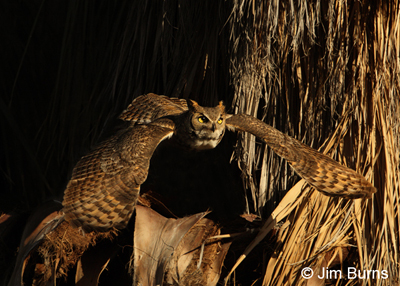
During the shorter daylight hours of winter and spring I am typically out for my morning run on the greenbelt well before daylight. At that hour I see, but mostly hear, more Great Horned Owls than the occasional walker or bicycler. Then, as winter warms to spring, I will begin begin to hear thrashers, mockingbirds, and eventually Western Kingbirds and Say’s Phoebes as the latter two catch insects drawn to the few lights on the path. Since the pandemic, though, many mornings I don’t see a “living soul” as my grandmother used to say.
I met my NBF one morning in the fall, walking toward me as I was running. I had just heard Great Horned Owls duetting and, in a fever fog of excitement about those vocalizations, I was running on auto pilot, unaware of anything else. I have Great Horned tagged in my bird log as “Five Hooter” to differentiate it at a glance from “Eight Hooter,” the Barred Owl, but it is only the male Great Horned which gives the deep, resonant five syllable “Whoo” notes we associate with that species. Once paired on territory, Great Horned mates begin duetting, and with close attention their calls can be distinguished by gender, the female’s six to seven “Whoo” notes higher pitched, quicker, and less monotonous.
Focused as I was on this, the first duetting I had heard since the previous nesting season, I suddenly noticed a person standing in total darkness several feet off the path, shrouded in a hooded jacket. After the initial adrenaline rush I realized it was someone waiting for me to pass before resuming their walk on the pathway. I was so momentarily startled I said nothing, but I heard music, apparently from earbuds. Van Morrison—“Brown-eyed Girl.”
I was never a big Van Morrison fan, but this song was special for my wife and me when it was released in 1967. We had not been married too long, some lyrics in the song paralleled events in our relationship and, as you might suspect, my wife has brown eyes. The song is my ring tone on her cell phone. Little did I know this mysterious figure, listening to Van Morrison in the dark, would become the one and only new friend I would make during the pandemic.
Along the same route a week later, hearing no owls and more aware of my surroundings, I noticed this same person, unhooded now, and obviously a woman, again step off the path as I ran toward her. I run unmasked. She was unmasked but apparently being very precautious about social distancing, so out of respect I ran out of the path on my side to allow her more space as she waited. And I heard her music again, soft rock from the late ‘60s and ‘70s transporting me in time. Neither of us spoke.
The next time I saw her she was walking in the same direction as I, so out of courtesy I called out to her, “passing on your left,” as I approached from behind. Apparently her music was loud enough she hadn’t heard me coming. Startled, she jumped perceptibly and darted off the path. I felt bad about it, but kept running. As we passed on my return route she broke the ice, apologizing if her loud music had startled me. Remembering how she had reacted, I countered with my own apology to her.
Three days later we had our real icebreaker. Just as I again saw her ahead of me going in the same direction, I heard heavy panting and something scrabbling on the cement behind me! Whirling about, I saw a Weimaraner hurtling toward me. As my adrenaline kicked in I realized there was a couple out in the shadows on the golf course, apparently walking their dog, this dog, in the dark. Obviously unleashed. Yes, there is a leash law in Scottsdale, and I became unhinged.
Weimaraners are large dogs initially bred to chase down large game such as boars and bears. This one was closing on me fast. Startled out of my wits, I screamed at them, a few choice words included. The dog paused, then came again, two more times before they finally got it under voice control. I’m guessing the owls were not amused by this raucous intrusion into the quiet of their dark world, and the “music lady,” as I now referred to her, heard everything and called out to me as I passed her, using the same choice word that I had. “****ing idiots! That scared the hell out of me.”
The very next day as she came toward me I interrupted my run, said good morning, told her I loved her music, and that we must be about the same age. Now it’s all good between us. We always exchange smiles, wave good mornings, and inquire about the other’s health if our paths haven’t crossed for several days. Last week I mentioned I had gotten my first vaccine dose.
I wouldn’t recognize the “music lady” in daylight if she knocked on my door, but I now have something to look forward to on my morning run besides the owls and, just like the owls, I never know if or where on my route I’ll meet her. And I’m thinking seriously about one of these mornings stopping and telling her about the owls. Her music may be too loud for her to hear them but, who knows, maybe she’s a birder or would enjoy becoming one. A strange new friendship for these strange times.